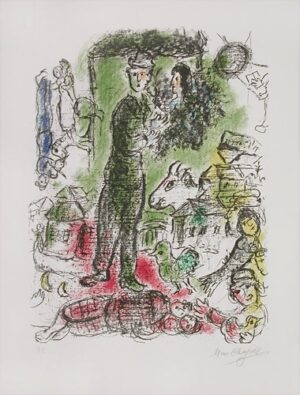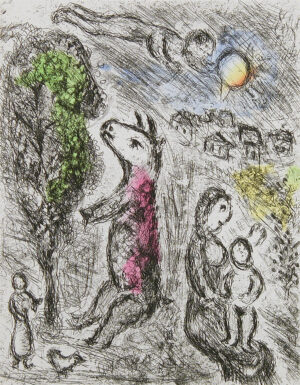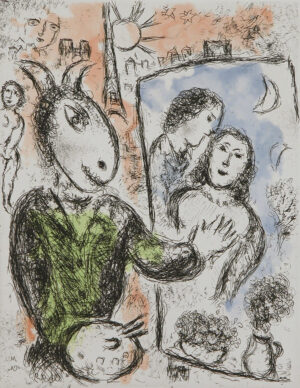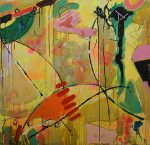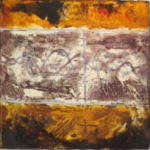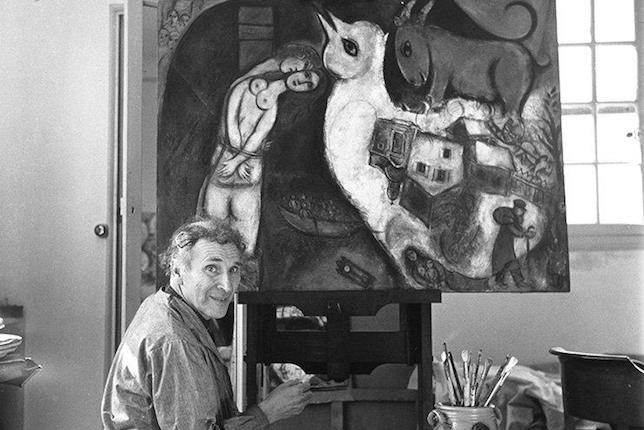
Marc Chagall (1887-1985) was at odds with the century in which he lived. Despite this, Chagall’s reputation is now secure as one of the most critically acclaimed and popular artists of the century. In an age of science and reason, Chagall defied these prevailing standards by seducing the viewer through the illogical inventiveness of his subject matter and his dazzling use of color. Chagall’s popularity, in part, is due to his art being resistant to over-intellectualization which is the fate of so much art in the past century. Chagall himself rejected being labeled and steadfastly wished his art to be unaligned with the major art movements of the century.
Chagall thought himself as the opposite of Picasso. He said, “Picasso painted with his belly and me, I paint with my heart.” In a 1944 interview he remarked, ”For me a picture is a plane surface covered with representations of objects-beasts, birds, or humans- in a certain order in which anecdotal illustrational logic has no importance. The visual effectiveness of the painted composition comes first. Every extra-structural consideration is secondary. I am against the terms fantasy and symbolism in themselves. All our interior world is reality-and that perhaps more so than our apparent world. To call everything that appears illogical, fantasy, fairy tale, or chimera would be practically to admit not understanding nature.”
Cubism, Futurism, and other advanced art movements of the day were both a shock and a revelation to Chagall. Their influences advanced, and then eventually receded from his art. His mature style, established by the 1920s, consisted of expressively rendered representation in imaginative, even magical compositions with people, animals, and objects often defying gravity and logic. The unifying force in his art, however, was color. Rich, complex, and layered, Chagall’s color floats like chromatic mists across the surface of his work.
While in exile in America, he was finally given his first opportunity to create color prints. The series of 13 color lithographs illustrating Four Tales from the Arabian Nights were begun in 1946 and published in 1948. This publication was an extraordinary achievement considering that it was Chagall’s first venture into that medium and that it was printed in New York, devoid of the tradition and skills of color printing that Paris had in abundance.
In 1948 in the workshop of the Parisian lithographic printer Fernand Mourlot, Chagall finally found his home as a printmaker. Under the patient tutelage of printers like Charles Sorlier, Chagall found color lithography to be the perfect graphic medium for his art.
The crowning achievement of Marc Chagall’s career as a printmaker is the suite of 42 luminous color lithographs illustrating Daphnis and Chloe by Longus, which was published in 1961. It was through the friendship of Chagall’s longtime Greek friend and publisher Teriade (1897–1983) that he was introduced to this classic text of antiquity. In order to assimilate himself with the spirit of the story, Chagall travelled to Greece in 1952 before producing the gouaches that served as the models for these prints. In 1954 he returned once more to Greece, “to see if I hadn’t been mistaken and to check whether my first impressions had been the right ones.”
The painstaking translation of the gouaches into lithography began in 1957 and went on for four years. In the end approximately 1,000 zinc plates were needed to produce the series of 42 lithographs. Some of the prints required up to 25 colors. The teamwork required to produce such a complex publication was truly amazing.
In his greatest color lithographs, such as Daphnis and Chloe, Marc Chagall created works that are the equal of his finest achievements in painting, drawing, stained glass, and ceramics. Henri Deschamps contributed the wonderful remark, “Chagall, they say he came into the world every morning.” To see life afresh each day, to act on one’s imagination and impulses in creating an art based on a poetry of feeling is Chagall’s gift to the world. His work is done, his achievement secure. It is for us to appreciate his genius and take refuge from an often uncomprehending world in the beauty he left us.
Chagall’s paintings and prints are found in permanent museum collections all over the world.
Essay Source: Weinstein Gallery


